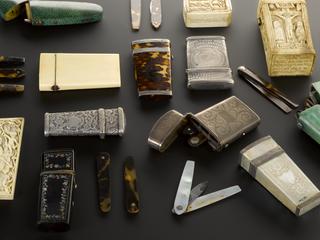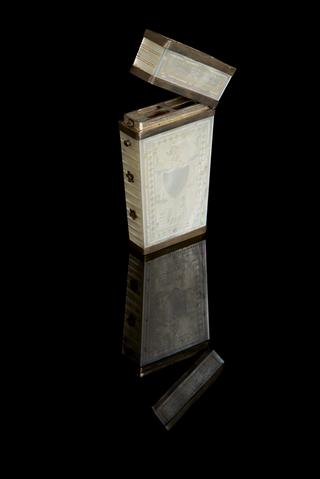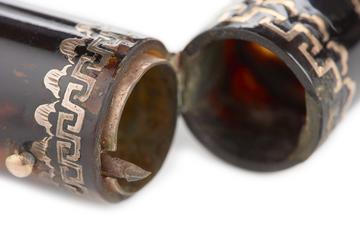Military medicine chest, German Army issue, contents incomplete, 1914-1918
Military medicine chest, German Army issue, contents incomplete
Details
- Category:
- Therapeutics
- Collection:
- Sir Henry Wellcome's Museum Collection
- Object Number:
- A665216
- Materials:
- chest, pine and chest, iron
- type:
- instruments, medical, medical panniers and field medical panniers
Parts
Leg splint
Leg splint, in two sections, German, 1914-1918
Box for catgut empty
Box for catgut empty, Germany, 1917
Two enema syringes inn wooden box
Two enema syringes inn wooden box, Germany, 1914-1918
- Materials:
- box, wood and syringe, vulcanite, metaled, glassed
- Object Number:
- A665216 Pt9
- type:
- enema syringes
Metal irrigator
Metal irrigator, with rubber tube, Germany, 1914-1918
Cloth bandage packet
Cloth bandage packet, Germany, 1914-1918
Two books of identity tags
Two books of identity tags, for attaching to wounded soldiers to give information about injuries and treatment, Germany, 1914-1918
More
During the First World War (1914-1918), battle casualties could be overwhelming and with limited time and resources, treatment had to be prioritised. Using various forms of ‘triage’ were employed and care was mainly concentrated on those who might both survive and ideally also be made battle-ready again.
To classify and identify them, wounded soldiers had a label - sometimes called tags or tallies - tied to them which gave information about wounds and treatment given. This could incorporate triage decisions, for example through colour coding.
Four bandage packets
Four bandage packets, Germany, 1917
Two packets of rolls of zine oxide plaster
Two packets of rolls of zine oxide plaster, Germany, 1914-1917
21 packets of banadages
21 packets of banadages, Germany, 1917
Three boxes of 10 ampoules of caffeine sodium salicylate solution
Three boxes of 10 ampoules of caffeine sodium salicylate solution, Germany, 1917
Box of 4 (of original 5) glass ampoules of dilute hydrochloric acid
Box of 4 (of original 5) glass ampoules of dilute hydrochloric acid, Germany, 1916
Box of 10 ampoules of scopolamine hydrobromide solution
Box of 10 ampoules of scopolamine hydrobromide solution, Germany, 1916
Box of mercury ointment
Box of mercury ointment, Germany, 1914-1918
Box of boric acid ointment
Box of boric acid ointment, Germany, 1914-1918
Box of containers of formaldehyde ointment and salicylic suet
Box of containers of formaldehyde ointment and salicylic suet, Germany, 1914-1918
Box of pepper tablets
Box of pepper tablets, Germany, 1914-1918
Box of cork stoppers
Box of cork stoppers, Germany, 1914-1918
Box of sugar crystals
Box of sugar crystals, Germany, 1914-1918
Boxed bottle of carbolic acid
Boxed bottle of carbolic acid, Germany, 1914-1918
Boxed bottle of tincture of iodine
Boxed bottle of tincture of iodine, Germany, 1914-1918
Box of mercuric chloride tablets
Box of mercuric chloride tablets, Germany, 1914-1918
Box of ointment
Box of ointment, Germany, 1914-1918
Rectangle based bottle, containing tincture of opium (tinctura opii simplex)
Tall, rectangle based clear glass bottle with glass stopper; transfer printed label. Bottle containing approximately 2 ounces of tincture of opium (tinctura opii simplex).
Bottle of salicylic talc powder
Bottle of salicylic talc powder, Germany, 1914-1918
Box of calcium sulphate powder
Box of calcium sulphate powder, Germany, 1914-1918
Wooden box of 47 (of original 50) tubes of tablets
Wooden box of 47 (of original 50) tubes of tablets, Germany, 1917
Two phials of Opium and Ipecac tablets
Two glass phials each containing two paper packets of .3g tablets of Opium and Ipecacuanha (Pulv. Ipecac. op.). Each: 100 mm x 15 mm diameter, 22 g. Issued by the German Army during the First World War, 1914-1918.




